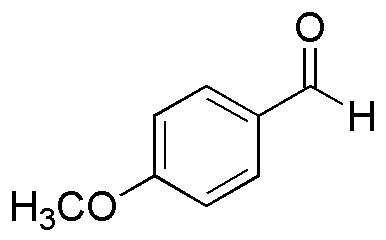p-Anisaldehyde is widely utilized in research focused on:
- Flavor and Fragrance Industry: Commonly used as a flavoring agent in food products and as a scent in perfumes, it provides a sweet, floral aroma that enhances consumer appeal.
- Synthetic Organic Chemistry: Serves as a key intermediate in the synthesis of various organic compounds, including pharmaceuticals and agrochemicals, facilitating the development of new drugs and crop protection agents.
- Analytical Chemistry: Employed as a reagent in various analytical techniques, such as chromatography, to help identify and quantify other compounds in complex mixtures.
- Polymer Production: Utilized in the production of certain polymers and resins, contributing to materials with enhanced properties, such as improved durability and resistance to environmental factors.
- Biological Research: Investigated for its potential biological activities, including antimicrobial and antioxidant properties, which can lead to the development of new therapeutic agents.
General Information
Properties
Safety and Regulations
Applications
p-Anisaldehyde is widely utilized in research focused on:
- Flavor and Fragrance Industry: Commonly used as a flavoring agent in food products and as a scent in perfumes, it provides a sweet, floral aroma that enhances consumer appeal.
- Synthetic Organic Chemistry: Serves as a key intermediate in the synthesis of various organic compounds, including pharmaceuticals and agrochemicals, facilitating the development of new drugs and crop protection agents.
- Analytical Chemistry: Employed as a reagent in various analytical techniques, such as chromatography, to help identify and quantify other compounds in complex mixtures.
- Polymer Production: Utilized in the production of certain polymers and resins, contributing to materials with enhanced properties, such as improved durability and resistance to environmental factors.
- Biological Research: Investigated for its potential biological activities, including antimicrobial and antioxidant properties, which can lead to the development of new therapeutic agents.
Documents
Safety Data Sheets (SDS)
The SDS provides comprehensive safety information on handling, storage, and disposal of the product.
Product Specification (PS)
The PS provides a comprehensive breakdown of the product’s properties, including chemical composition, physical state, purity, and storage requirements. It also details acceptable quality ranges and the product's intended applications.
Certificates of Analysis (COA)
Search for Certificates of Analysis (COA) by entering the products Lot Number. Lot and Batch Numbers can be found on a product’s label following the words ‘Lot’ or ‘Batch’.
*Catalog Number
*Lot Number
Certificates Of Origin (COO)
This COO confirms the country where the product was manufactured, and also details the materials and components used in it and whether it is derived from natural, synthetic, or other specific sources. This certificate may be required for customs, trade, and regulatory compliance.
*Catalog Number
*Lot Number
Safety Data Sheets (SDS)
The SDS provides comprehensive safety information on handling, storage, and disposal of the product.
DownloadProduct Specification (PS)
The PS provides a comprehensive breakdown of the product’s properties, including chemical composition, physical state, purity, and storage requirements. It also details acceptable quality ranges and the product's intended applications.
DownloadCertificates of Analysis (COA)
Search for Certificates of Analysis (COA) by entering the products Lot Number. Lot and Batch Numbers can be found on a product’s label following the words ‘Lot’ or ‘Batch’.
*Catalog Number
*Lot Number
Certificates Of Origin (COO)
This COO confirms the country where the product was manufactured, and also details the materials and components used in it and whether it is derived from natural, synthetic, or other specific sources. This certificate may be required for customs, trade, and regulatory compliance.


